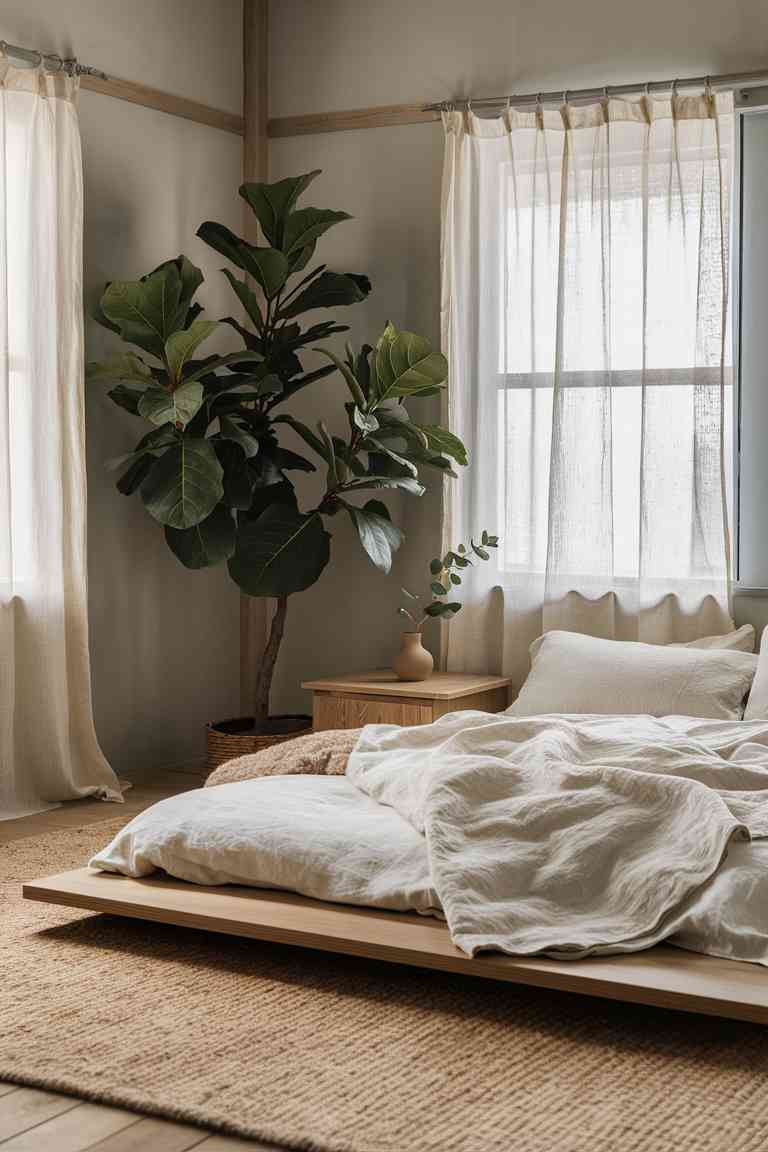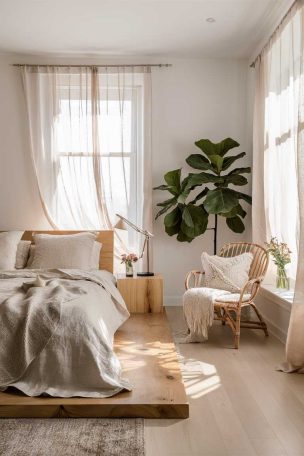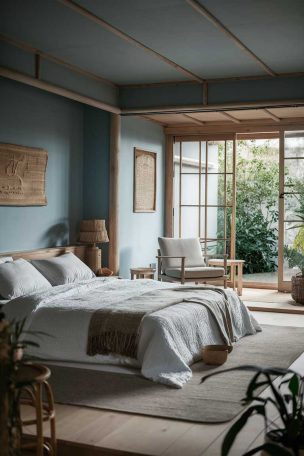The Japandi style has taken the interior design world by storm in recent years, offering a perfect fusion of Japanese minimalism and Scandinavian functionality.
When it comes to creating a serene and stylish bedroom, the Japandi aesthetic truly shines – especially when paired with carefully chosen indoor plants.
In this article, we’ll explore a wealth of Japandi bedroom with indoor plants ideas, helping you transform your space into a tranquil oasis that seamlessly blends design and nature.
What is Japandi-Style?
Japandi style is a beautiful marriage of Japanese and Scandinavian design principles.
It combines the warm minimalism of Scandinavian interiors with the elegant simplicity of Japanese aesthetics.
The result? A style that’s both functional and beautiful, emphasizing clean lines, natural materials, and a connection to nature.
In a Japandi bedroom, you’ll find a harmonious blend of simplicity and sophistication.
Think neutral color palettes, natural textures, and an overall sense of calm.
It’s about creating a space that feels both cozy and uncluttered – a true sanctuary for rest and relaxation.
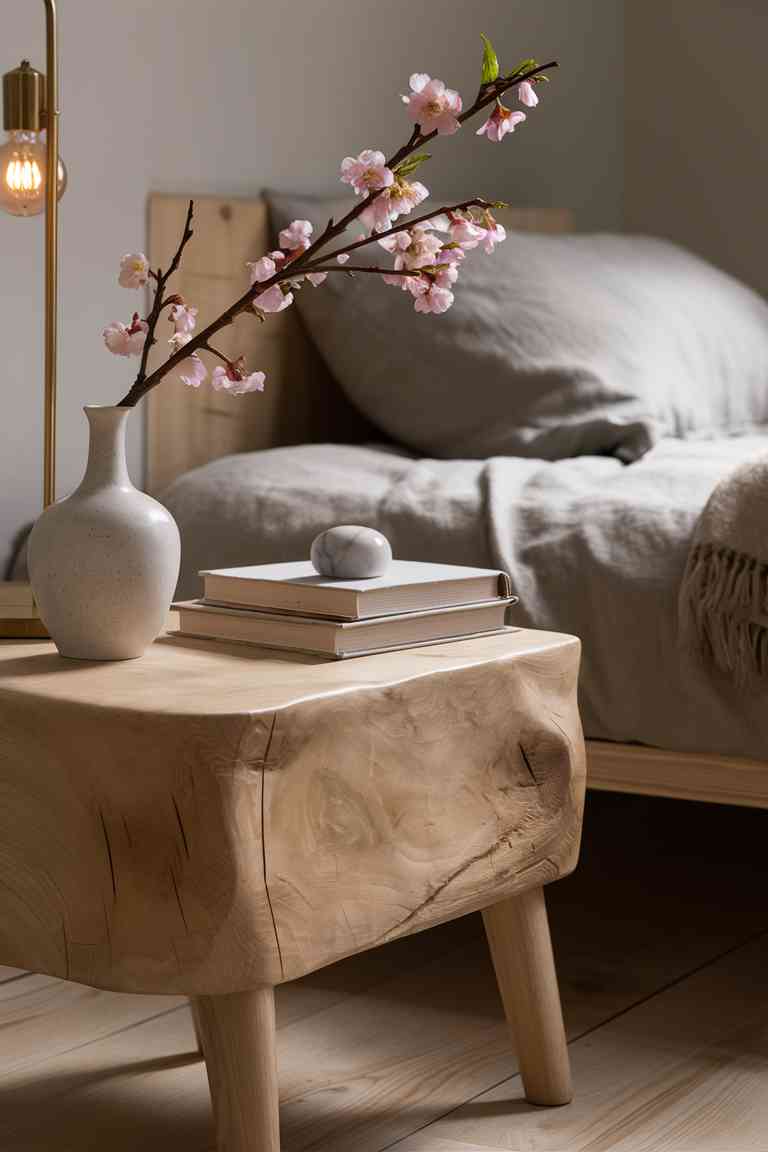
Key Elements of a Japandi Bedroom
Color Palette
The foundation of any Japandi bedroom is its color palette.
Stick to neutral tones like soft grays, warm beiges, and earthy hues.
These colors create a calming atmosphere that’s perfect for rest and relaxation.
Don’t be afraid to add depth with darker accents, like charcoal or deep brown, but use them sparingly to maintain the overall light and airy feel.
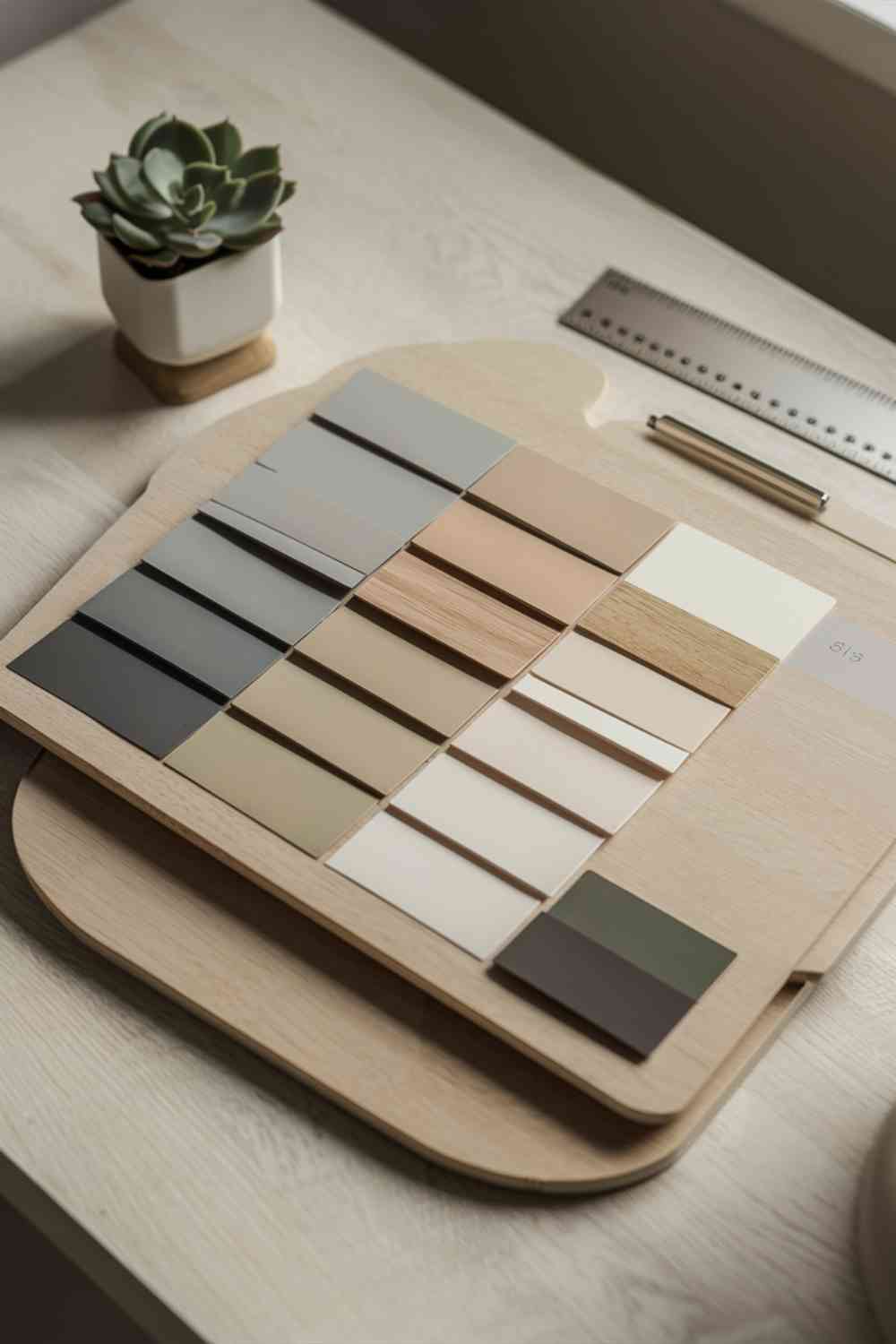
Materials
Natural materials are at the heart of Japandi design. Incorporate elements like wood, bamboo, and linen to bring warmth and texture to your space.
Light wood furniture, such as oak or ash, helps maintain an airy feel while adding a touch of organic beauty.
Consider a wooden bed frame, nightstands, or a statement dresser to anchor your Japandi bedroom.
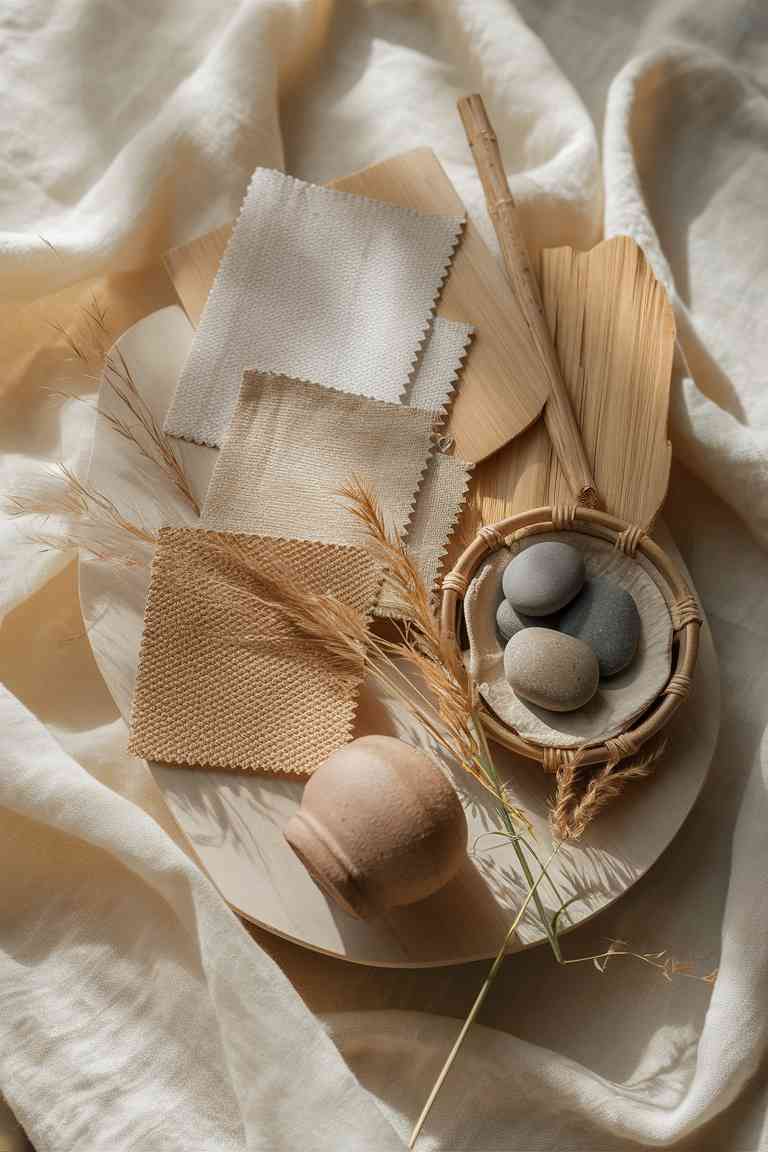
Furniture Style
Regarding furniture, less is definitely more in a Japandi bedroom.
Opt for low-profile bed frames that enhance the sense of spaciousness and align with the minimalist ethos of Japandi design.
Look for pieces with clean lines and simple silhouettes.
Choose functional furniture with built-in storage, like under-bed drawers or sleek, wall-mounted shelves, to keep the space clutter-free.
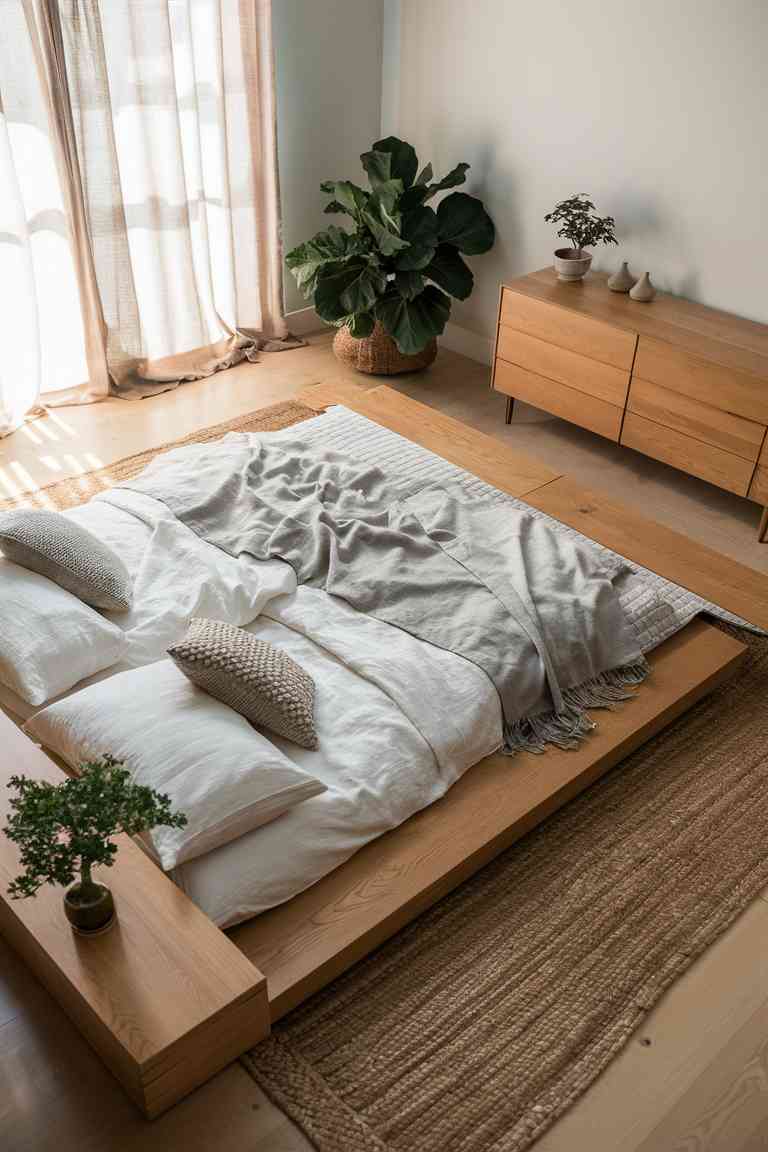
Incorporating Indoor Plants in Japandi Bedrooms
Now, let’s get to the heart of our topic: Japandi bedroom plant ideas.
Indoor plants are the perfect way to enhance the natural beauty and tranquility of your Japandi-inspired space.
They add visual interest, improve air quality, and create a deeper connection to nature.
Benefits of Indoor Plants
Before we dive into specific plant choices, let’s talk about why houseplants are such a fantastic addition to any bedroom, especially a Japandi-style one. Indoor plants can:
- Purify the air by removing toxins
- Increase humidity, which can improve sleep quality
- Reduce stress and promote relaxation
- Add a pop of color and life to your minimalist decor
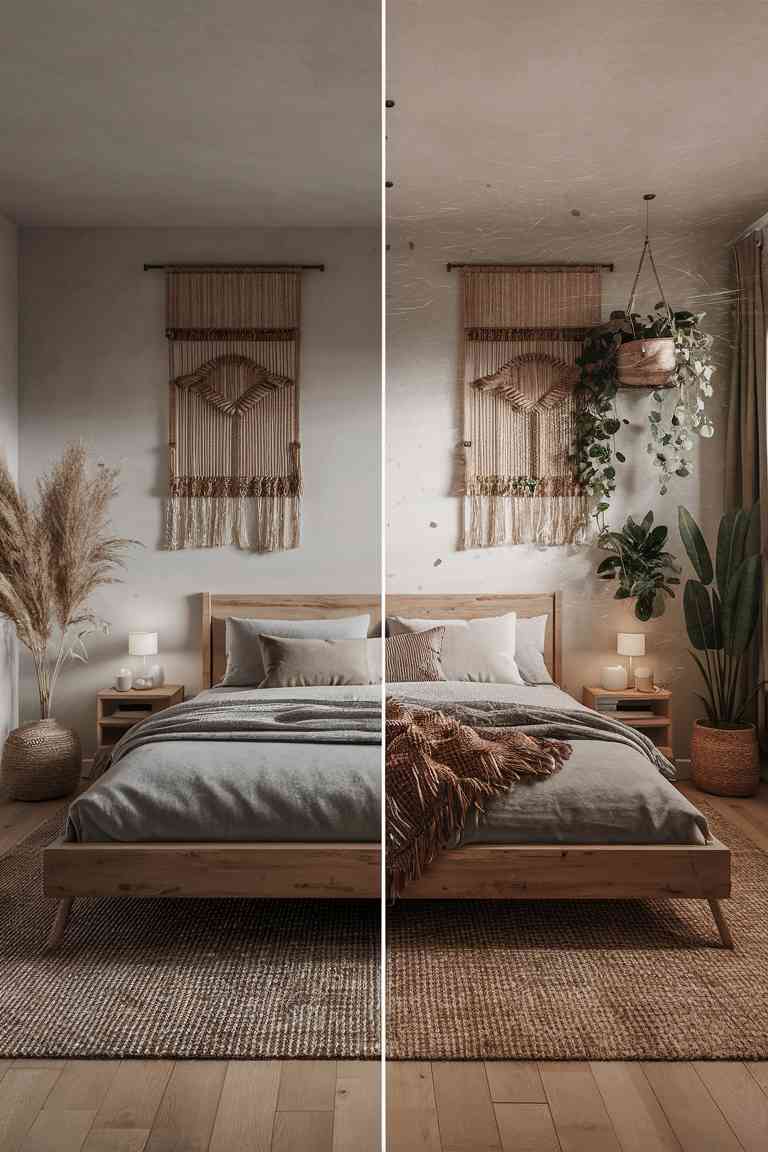
Choosing the Right Plants
When selecting plants for your Japandi bedroom, consider both aesthetics and practicality.
You want plants that complement your decor while thriving in your bedroom’s conditions. Here are some great options to consider:
Large Statement Plants
- Fiddle Leaf Fig (Ficus lyrata): This plant, with its large, violin-shaped leaves, makes a stunning focal point in any room. It thrives in bright, indirect light and adds a touch of drama to your space.
- Monstera: Also known as the Swiss Cheese Plant, the Monstera’s unique split leaves bring a tropical vibe to your bedroom. It’s relatively easy to care for and can tolerate lower light conditions.
- Bird of Paradise: Consider a Bird of Paradise plant for a striking addition to your Japandi bedroom. Its large, paddle-shaped leaves create a bold statement and can add height to your space.
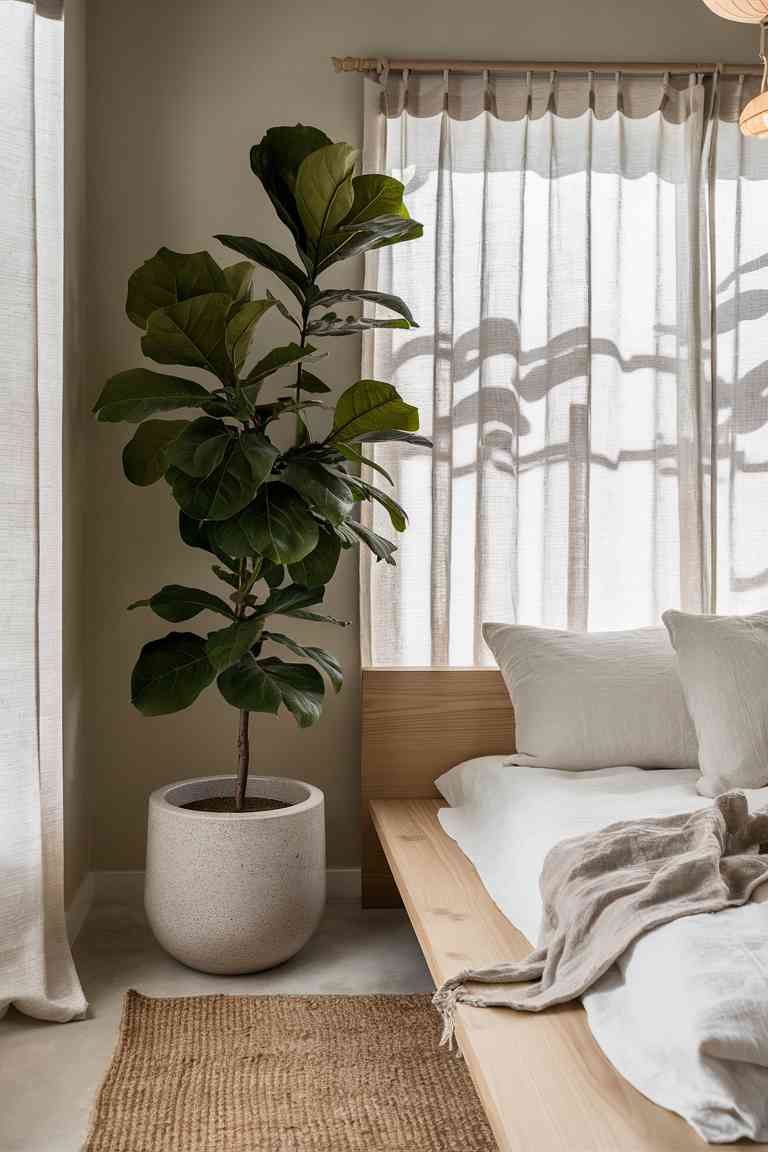
Medium-Sized Plants
- Snake Plant (Sansevieria): This is one of the best indoor plants for beginners. It’s incredibly low-maintenance and can thrive in various light conditions. Its tall, striking leaves add vertical interest to your space.
- Rubber Tree: Its dark, glossy leaves add a touch of sophistication to your japandi bedroom. It’s relatively easy to care for and can grow quite tall if you let it.
- Peace Lily (Spathiphyllum): This plant is known for its air-purifying qualities and is a great bedroom choice. Its elegant white blooms add a soft touch to your decor.
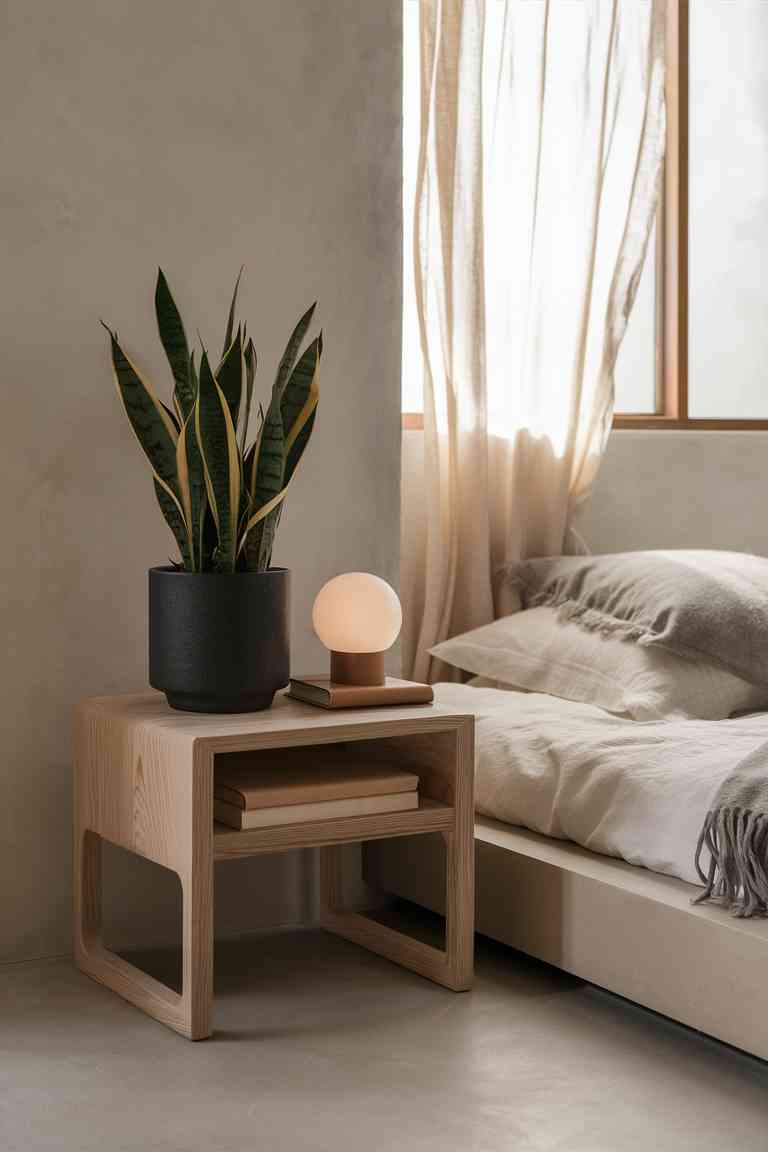
Small Accent Plants
- Succulents: These low-maintenance plants come in various shapes and sizes, perfect for adding texture to your space without overwhelming it.
- Air Plants: These unique plants don’t need soil to grow, making them an excellent choice for hanging displays or small decorative containers.
- Pothos: This trailing plant is perfect for adding a touch of greenery to shelves or hanging baskets. It’s also one of the easiest indoor plants to care for.
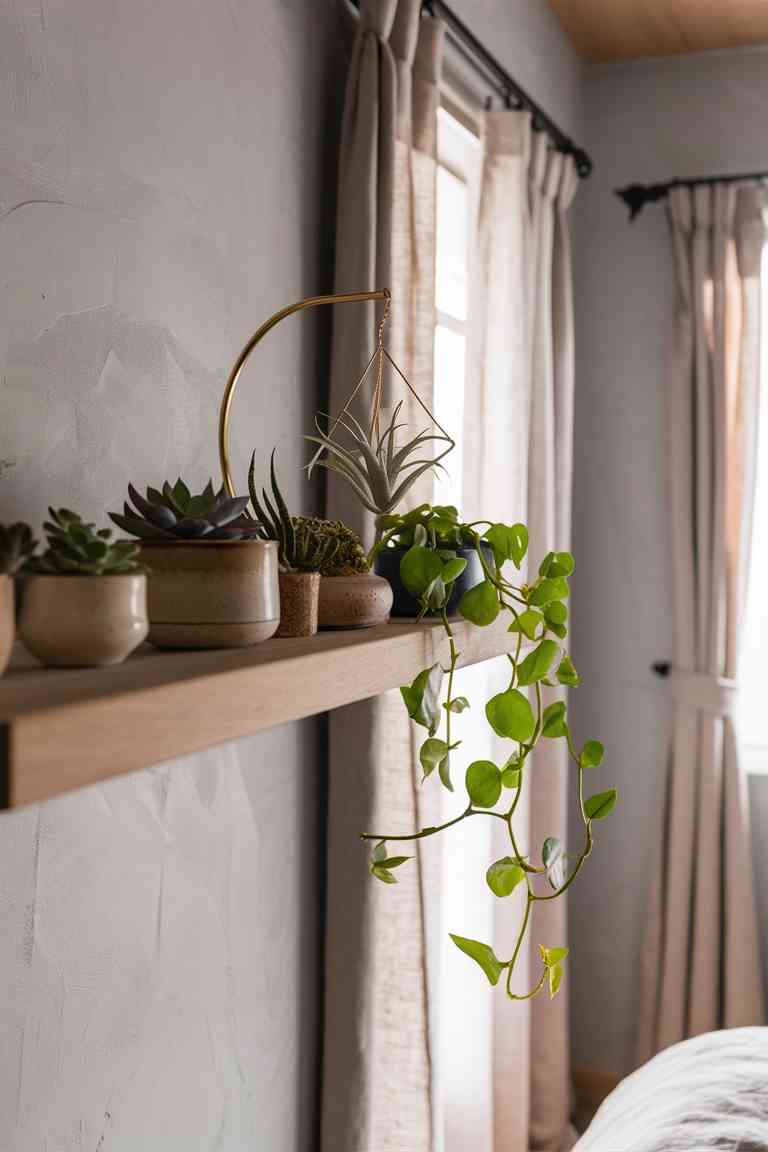
Creative Plant Displays
Now that we’ve covered some of the best indoor plants for your japandi bedroom, let’s explore creative ways to display them:
- Hanging plants: Use macramé hangers or sleek, modern planters to add visual interest at different heights.
- Vertical gardens: Create a living wall with a collection of plants in wall-mounted planters.
- Grouped arrangements: Cluster plants of varying heights and textures for a dynamic display.
Remember, balancing your plants and your Japandi bedroom’s minimalist aesthetic is key.
Don’t overcrowd your space – instead, choose a few statement pieces and arrange them thoughtfully.
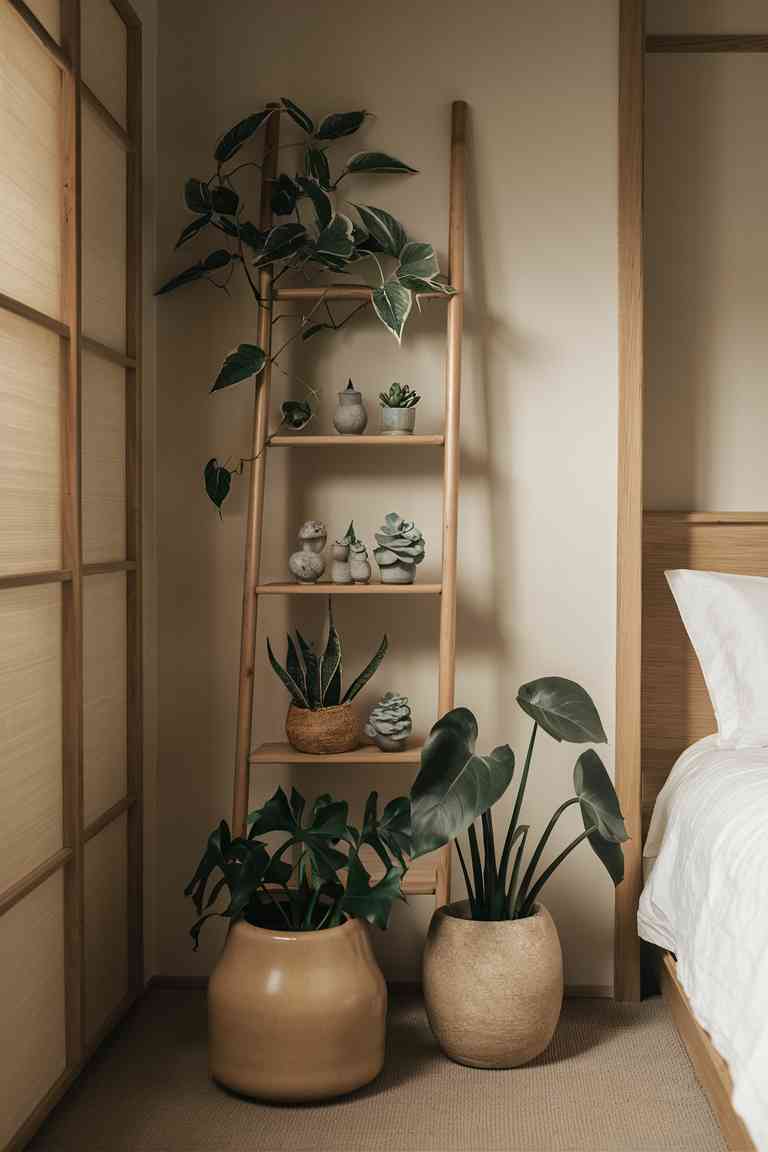
Japandi Bedroom Layouts with Plants
Now that we’ve covered the basics of Japandi bedroom with plants let’s explore some specific layout ideas to inspire your design:
Minimalist Japandi Bedroom
In this layout, less is more.
Choose a single statement plant, like a tall snake plant, as your centerpiece.
Place it in a corner where it can be admired without cluttering the space.
Keep the rest of your decor minimal with a low platform bed, simple nightstands, and perhaps a sleek dresser.
The focus here is on clean lines, open space, and the perfect plant that ties everything together.
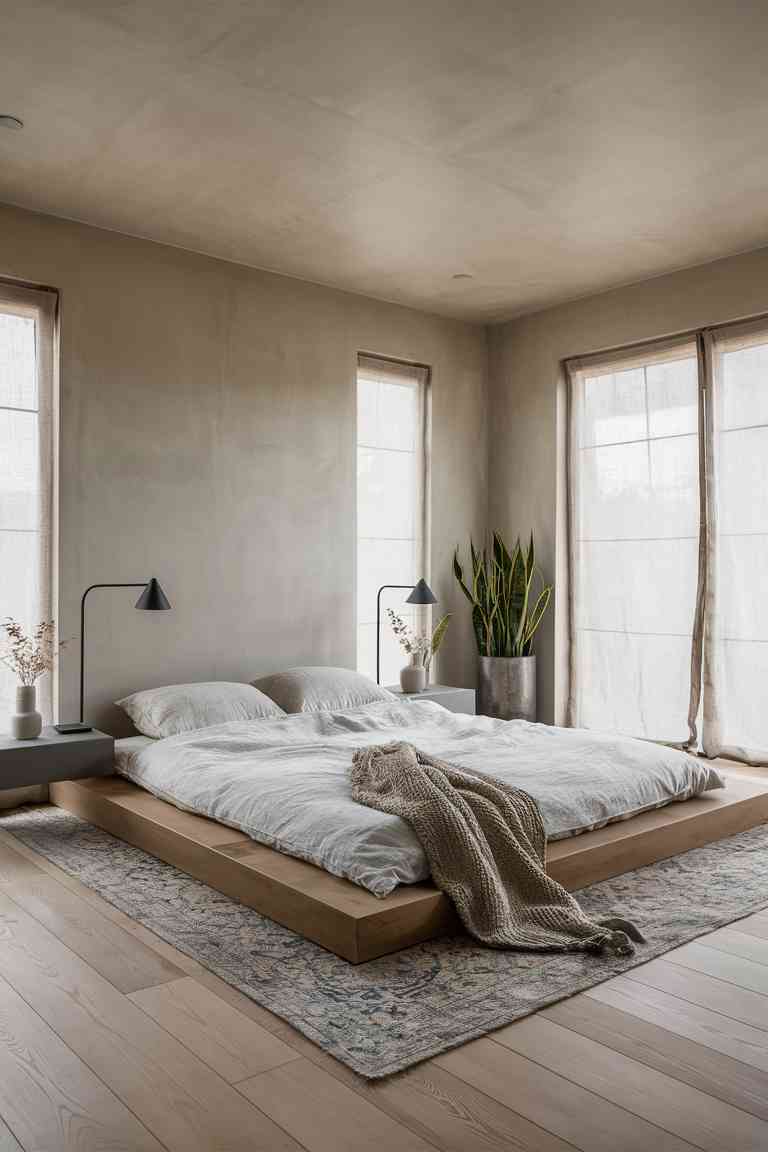
Modern Japandi Bedroom
Incorporate a pothos as your focal point for a more contemporary take on the Japandi style.
Let it trail down from a high shelf or hang it in a modern planter near a window.
Pair this with furniture that blends Japanese and Scandinavian design – think a low bed with a slatted wooden headboard or a dresser with subtle shoji screen-inspired details.
Add a few smaller plants in geometric planters to complete the modern look.
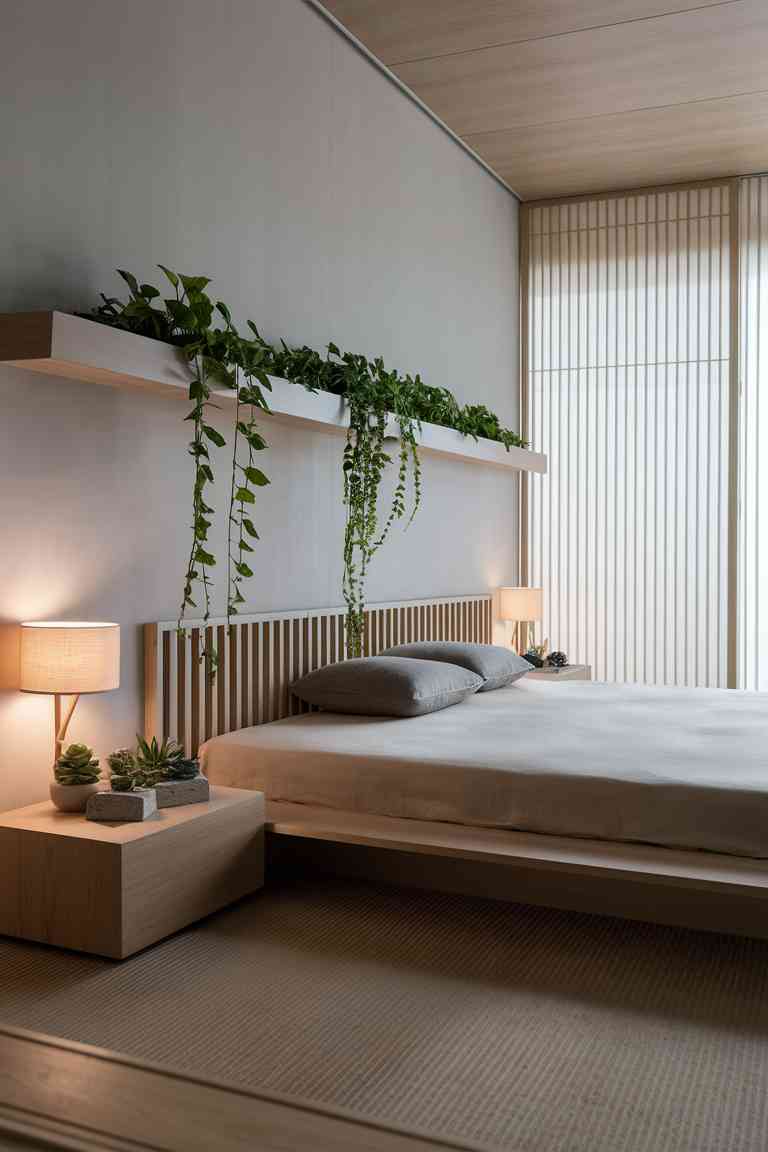
Spacious Japandi Bedroom
If you’re lucky enough to have a larger bedroom, you have the perfect canvas for a Japandi bedroom with indoor plant ideas.
Create a lush yet controlled environment by incorporating multiple plant varieties.
Place a large fiddle leaf fig tree in one corner, hang some trailing plants near the windows, and dot smaller plants throughout the room.
To maintain that calm Japandi feel, balance this greenery with plenty of open space, natural wood furniture, and a neutral color palette.
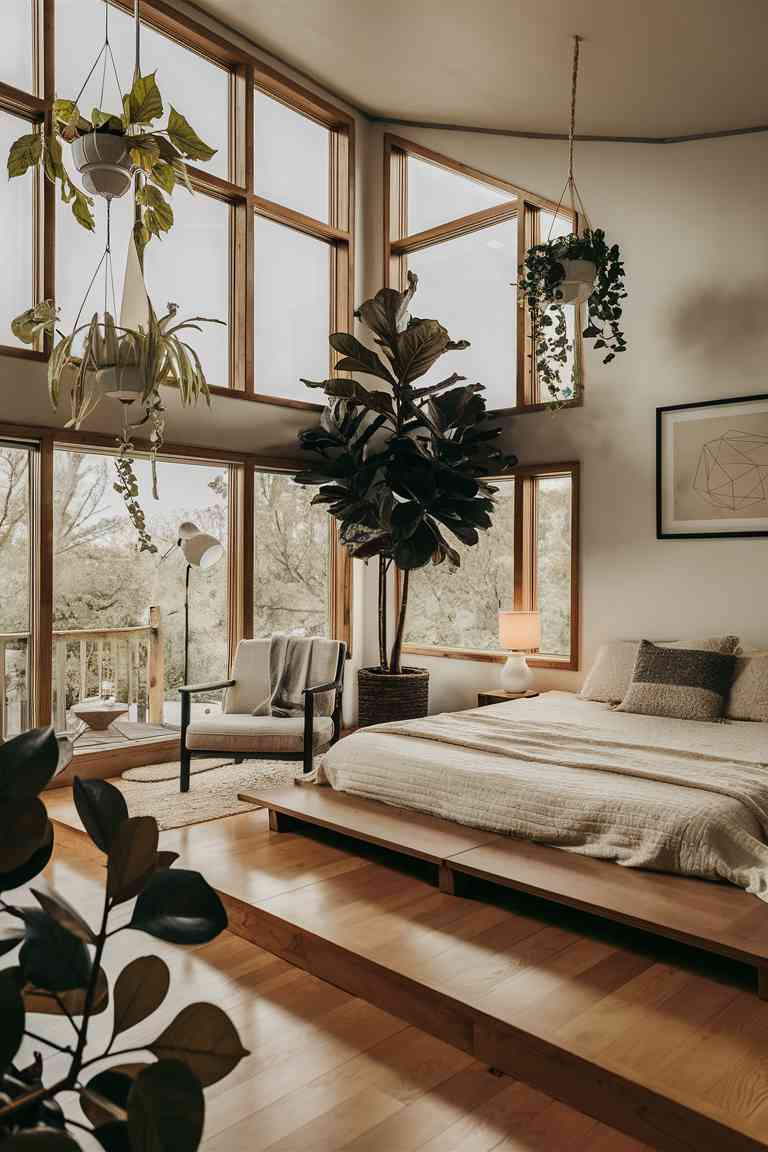
Cozy Japandi Bedroom
Even in a smaller space, you can create a cozy Japandi bedroom with plants.
Opt for a low platform bed and use the nightstand to showcase a small, low-maintenance plant, such as a snake plant or succulent.
Hang a pothos or string of pearls plant from the ceiling to add greenery without taking up floor space.
Use warm lighting and natural textures in your bedding and curtains to enhance the cozy feel.
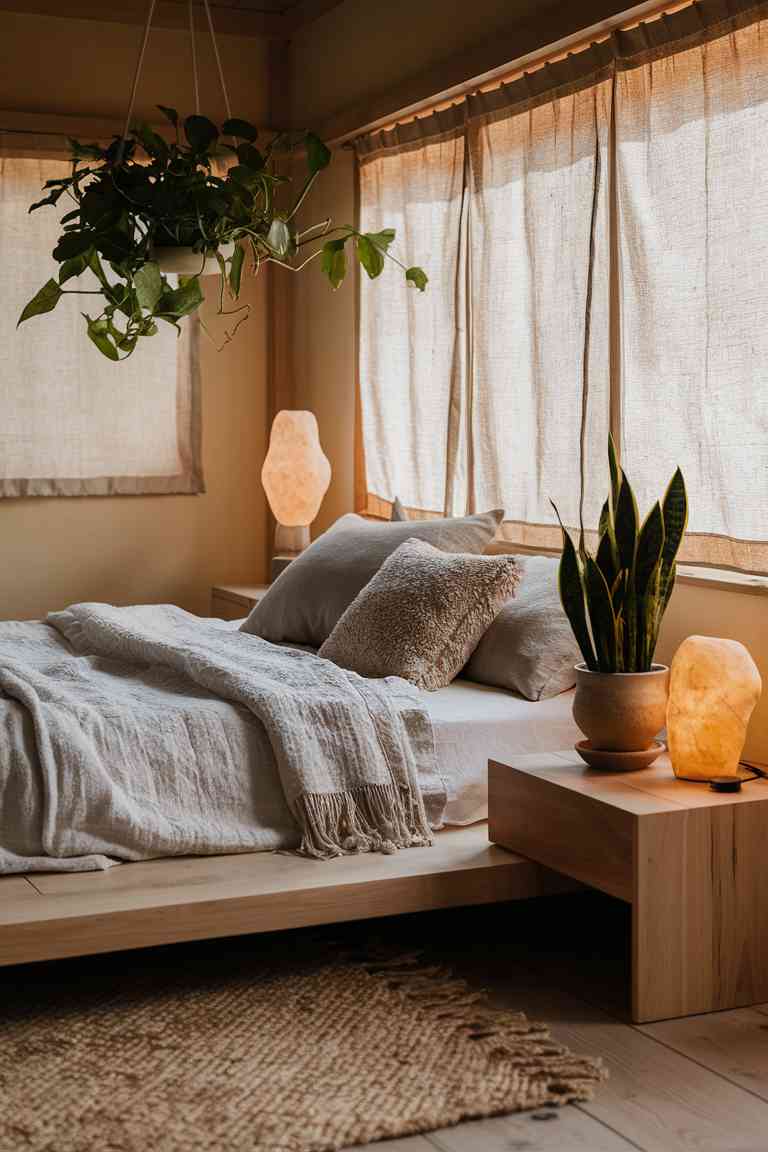
Japandi Bedroom Features Enhanced by Plants
Certain features in a bedroom lend themselves particularly well to incorporating plants in a Japandi style.
Let’s explore a few:
Window Seats
A window seat is perfect for creating a cozy reading nook in your Japandi bedroom.
Enhance this area with carefully chosen plants that thrive in bright light.
A collection of small succulents on the windowsill or a hanging plant cascading down next to the seat can create a serene, nature-inspired retreat.
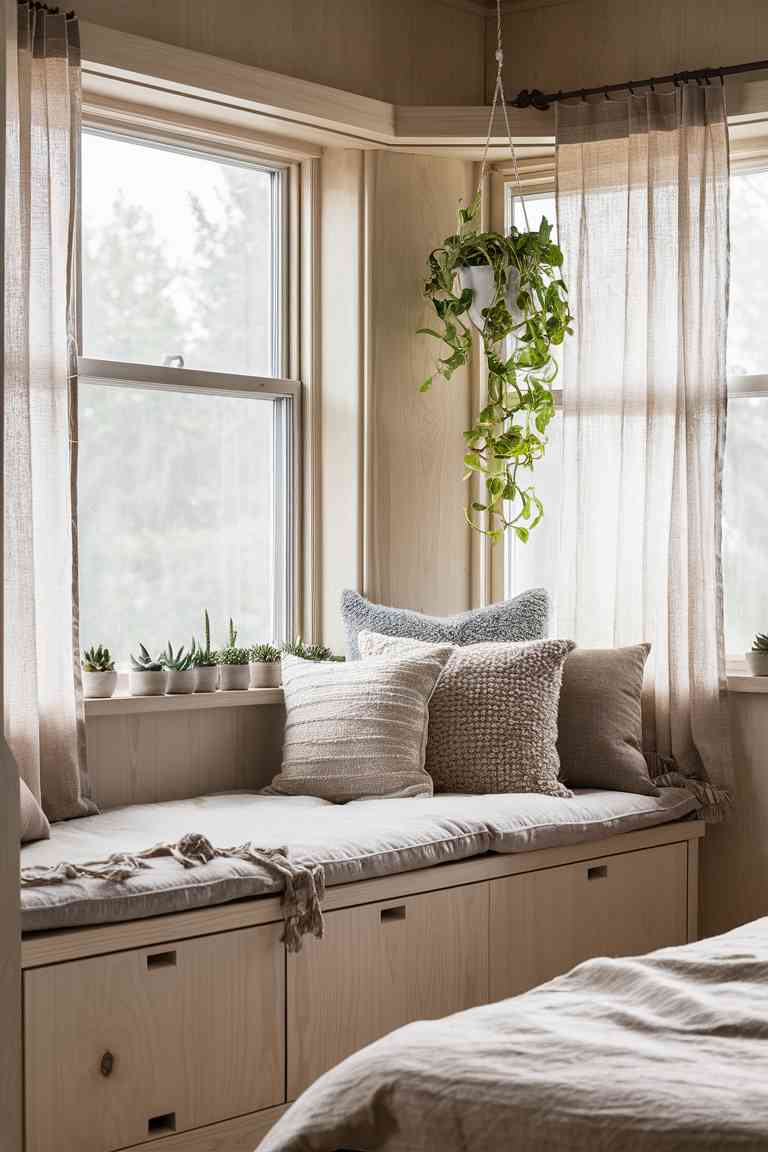
Lofts and Mezzanines
If your bedroom has a loft or mezzanine, use this height to your advantage when placing plants.
Tall statement plants like a fiddle leaf fig or bird of paradise can create a dramatic effect when placed on the lower level, reaching up towards the higher space.
On the upper level, trailing plants can create a cascade of greenery, softening the lines of your japandi bedroom.
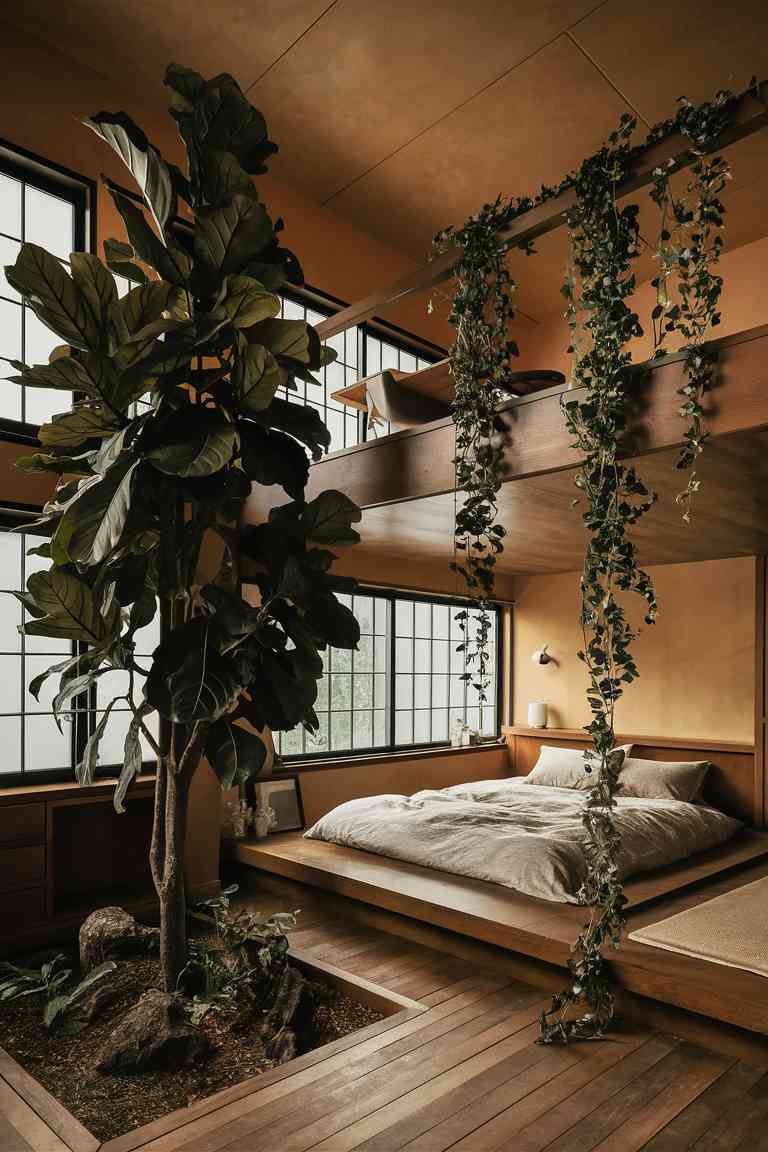
En-Suite Bathrooms
Extend your japandi bedroom with plants ideas into your en-suite bathroom for a cohesive look.
Bathrooms often provide the perfect humid environment for certain plants.
Place a large, leafy plant like a monstera near the bathtub, or hang air plants near the shower.
Just be sure to choose plants that can tolerate the higher humidity levels.
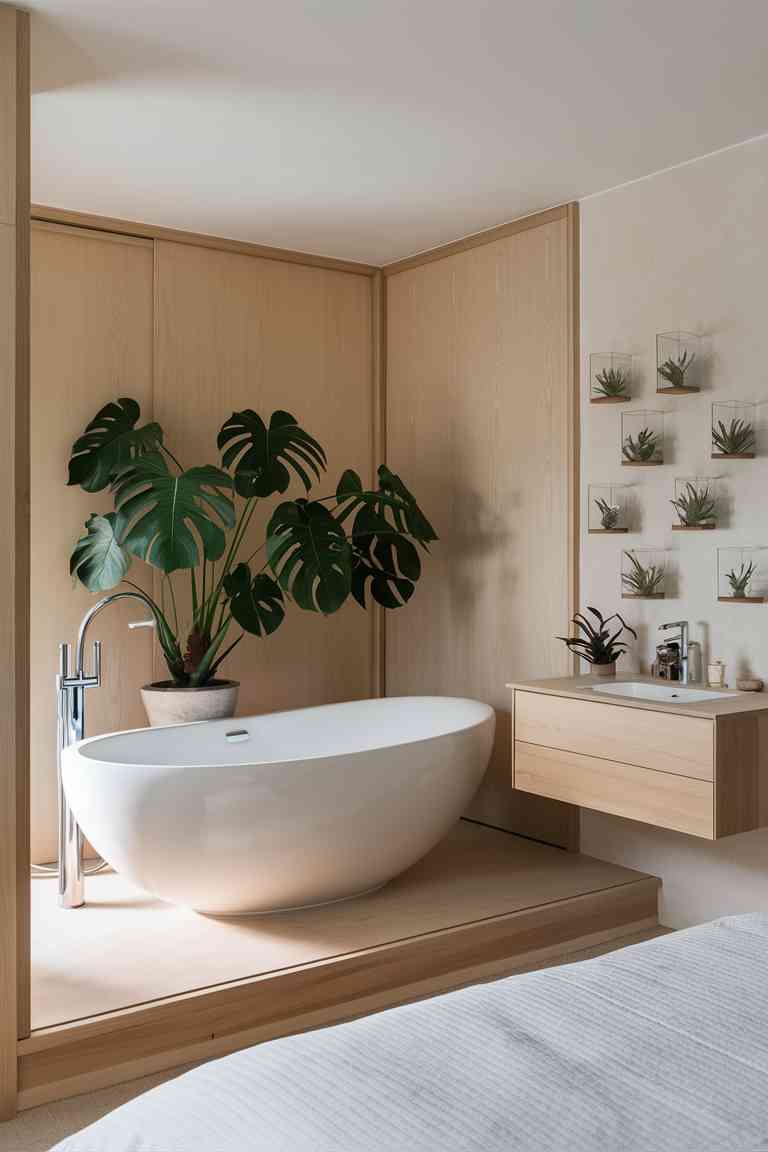
Balconies and Terraces
If your bedroom opens onto a balcony or terrace, this is a golden opportunity to blur the lines between indoor and outdoor spaces.
Use large potted plants like olive trees or bamboo to create privacy and extend your Japandi bedroom outdoors.
Choose planters that complement your interior decor to maintain a cohesive look.
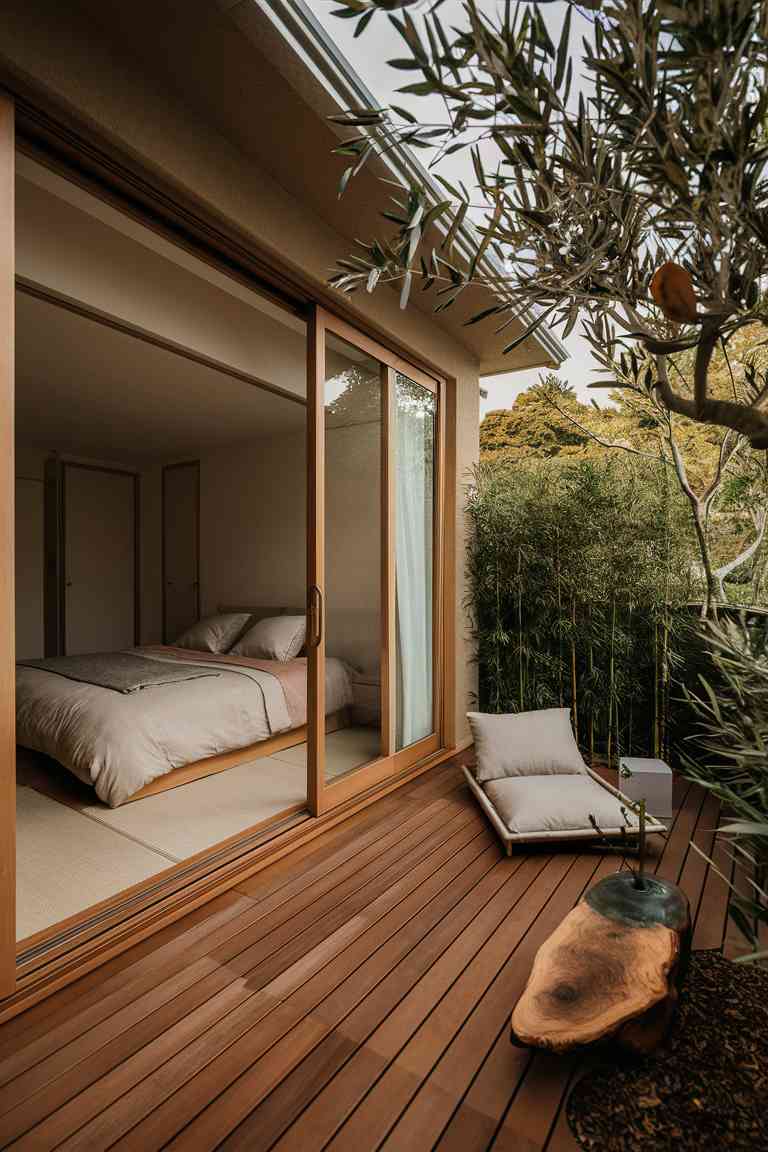
Styling Tips for Japandi Bedrooms with Plants
Now that we’ve covered layout ideas and features, let’s dive into some specific styling tips to perfect your Japandi bedroom with plants:
Planters and Containers
Choose planters that complement your Japandi aesthetic.
Opt for simple, minimalist designs in materials like ceramic, concrete, or light wood.
Stick to neutral colors or earthy tones that blend seamlessly with your decor.
Remember, the plants should be the stars – the containers should enhance, not overshadow them.
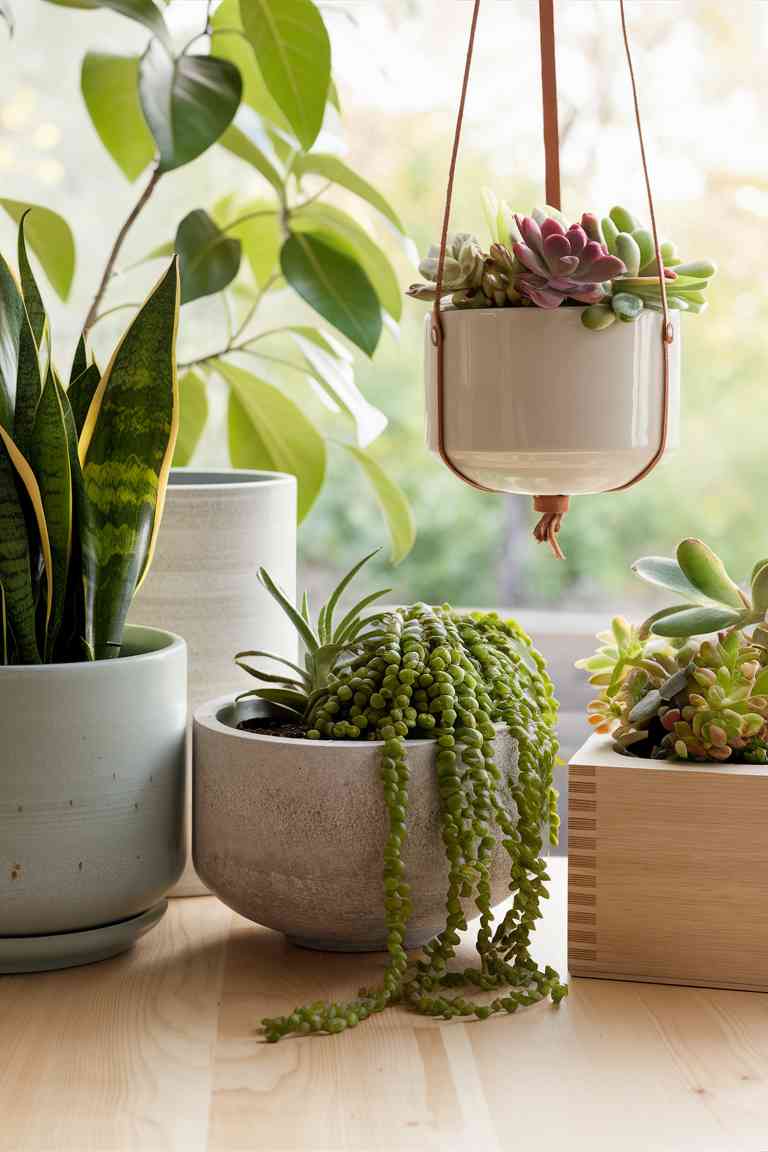
Textiles and Bedding
The right textiles can beautifully complement your japandi bedroom plants.
Opt for natural fabrics like linen, cotton, and wool in neutral tones.
These materials add texture and warmth to your space while maintaining a clean, minimalist aesthetic.
Consider layering different textures – a linen duvet cover, cotton sheets, and a chunky knit throw can create depth without cluttering your space.
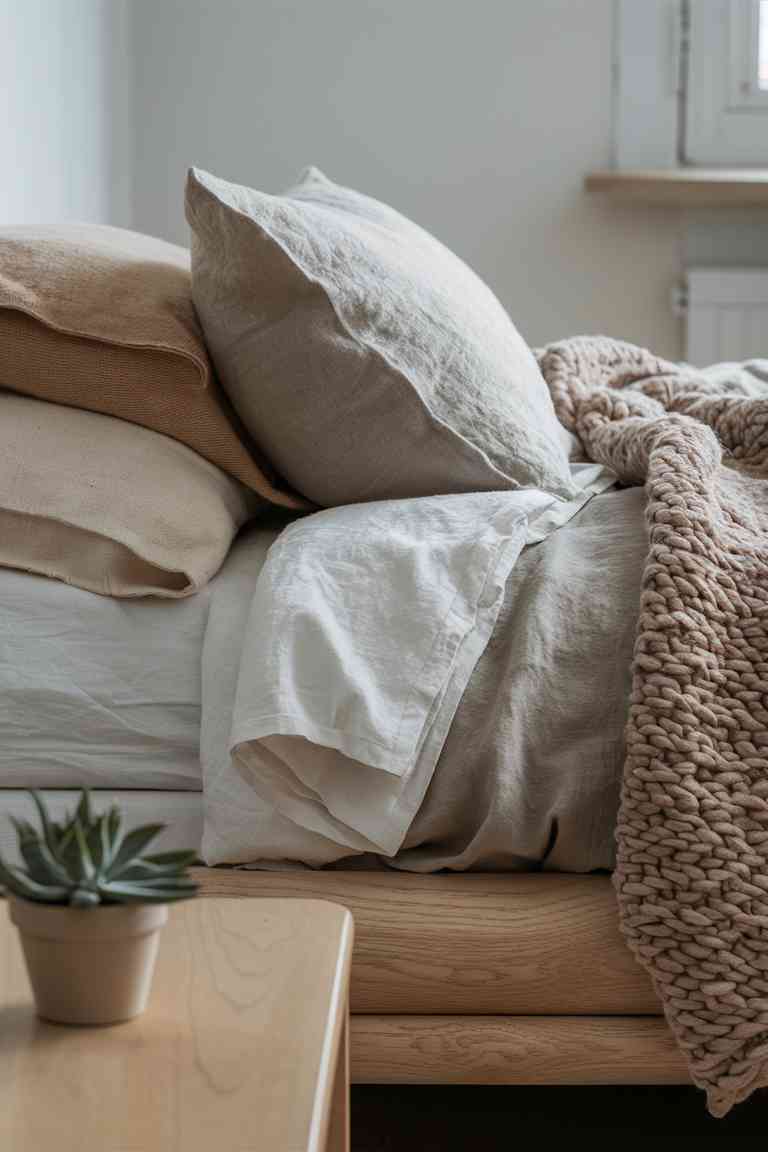
Lighting
Proper lighting is crucial in a japandi bedroom, especially when incorporating plants.
Aim for a mix of natural and artificial light sources.
Large windows with sheer curtains allow plenty of natural light for your plants while maintaining privacy.
For artificial lighting, choose fixtures with clean lines and natural materials.
Add ambient lighting with paper lanterns or minimalist floor lamps to create a cozy evening atmosphere.
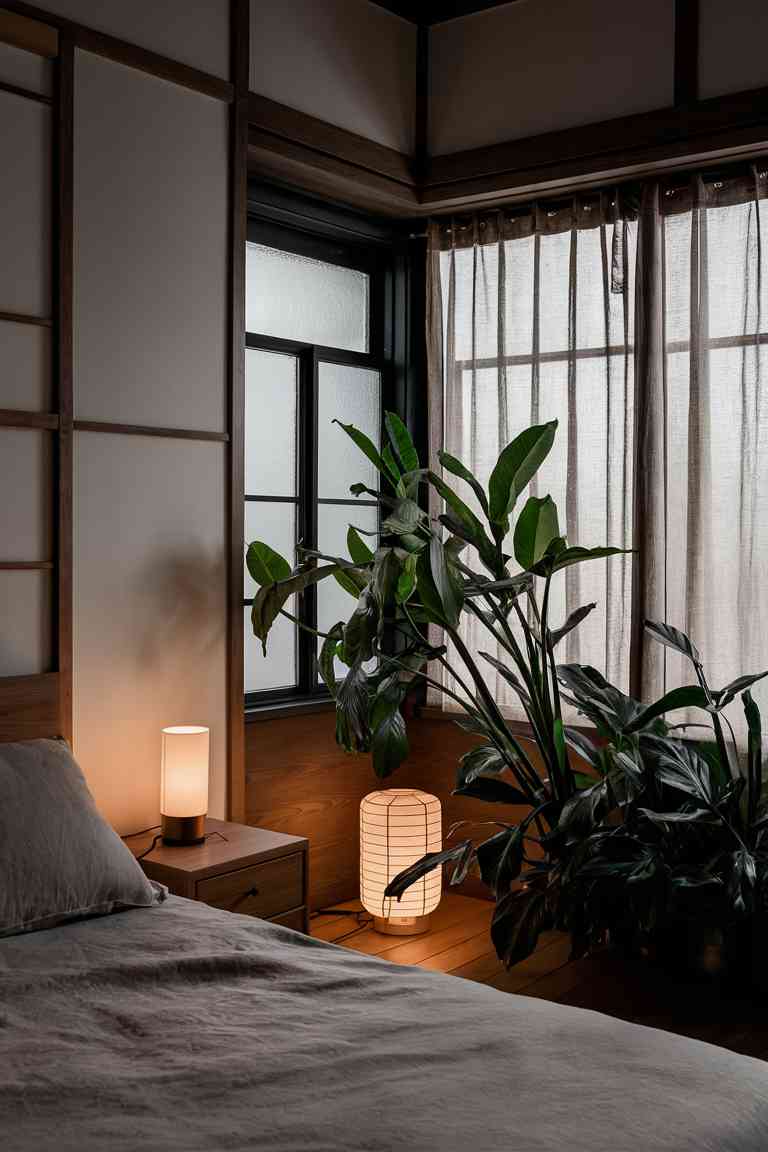
Artwork
When it comes to artwork in a japandi bedroom with plants, less is more.
Choose pieces that complement your natural theme without overwhelming the space.
Consider botanical prints, minimalist nature photography, or simple line drawings of plants.
Black and white pieces can add contrast to your neutral palette, while earthy tones can enhance the natural feel of your space.
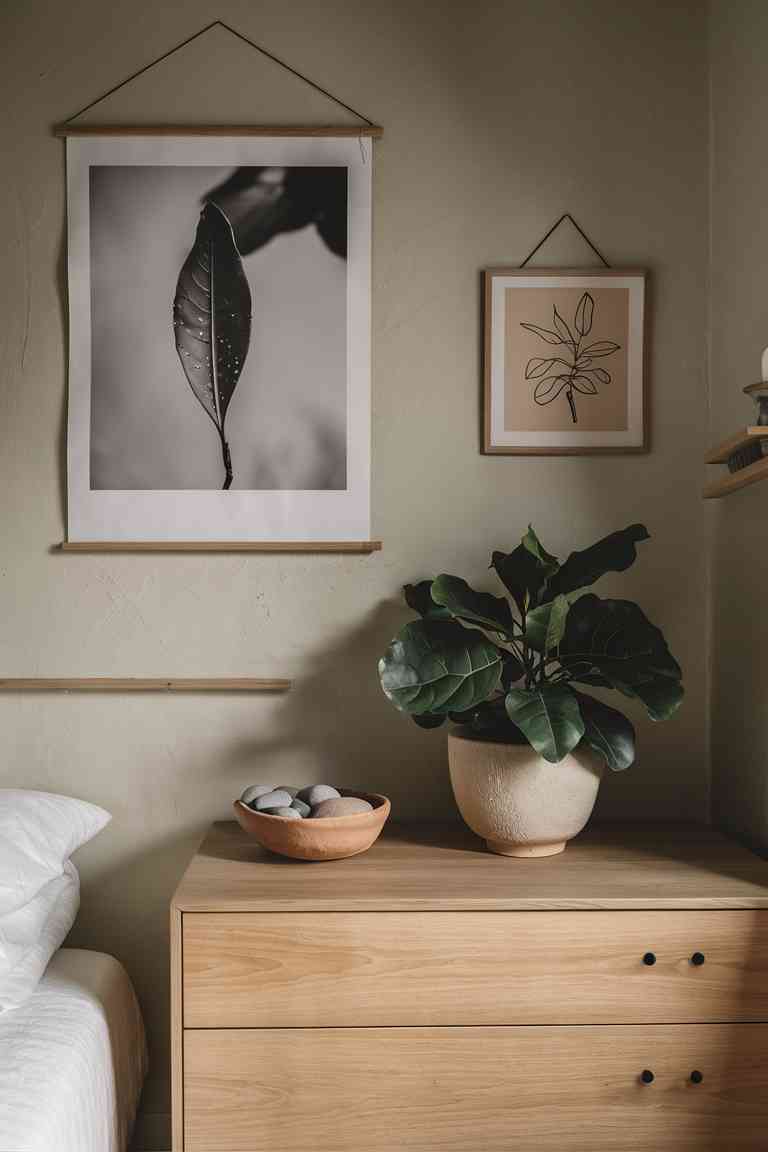
Maintenance and Care for Indoor Plants in Japandi Bedrooms
To keep your japandi bedroom plants looking their best, it’s essential to understand their care requirements. Here are some tips:
Watering and Light Requirements
Different plants have different needs when it comes to water and light.
Some low-light houseplants, like snake plants and pothos, can thrive in darker corners, while others, like fiddle leaf figs, need bright, indirect light.
Research the specific needs of your chosen plants and place them accordingly in your bedroom.
When it comes to watering, the general rule is to water deeply but infrequently, allowing the soil to dry out between waterings.
However, this can vary depending on the plant species, pot size, and your room’s conditions.
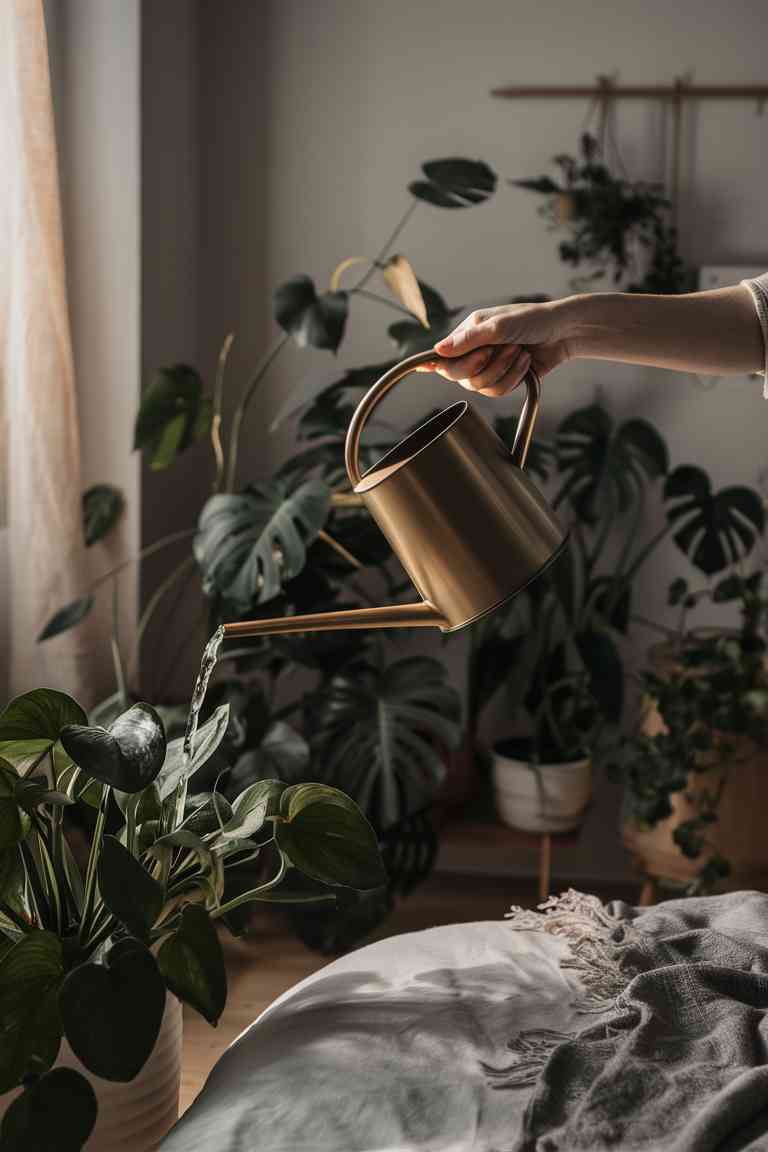
Pruning and Cleaning
Regular pruning helps maintain the shape of your plants and promotes healthy growth. Remove any dead or yellowing leaves promptly.
For larger leaves, like those on a fiddle leaf fig or rubber plant, regular dusting with a soft, damp cloth will keep them looking their best and help them photosynthesize more efficiently.

Seasonal Care Tips
Remember that your plants’ needs may change with the seasons.
In winter, most plants enter a dormant phase and require less water and fertilizer.
As they enter their growth phase, they may need more frequent watering and feeding in spring and summer.
Also, be mindful of temperature fluctuations.
Most indoor plants prefer stable temperatures between 60-75°F (15-24°C).
Avoid placing them near drafty windows or heating vents.
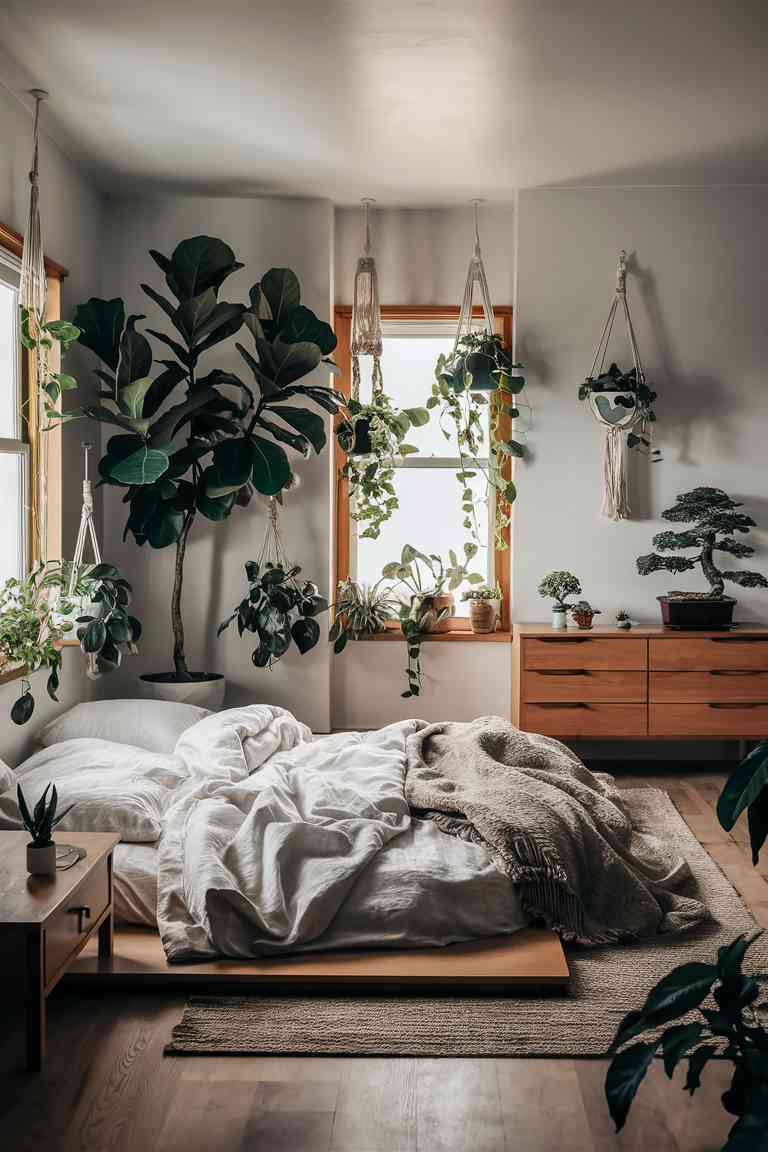
Conclusion
Creating a Japandi bedroom with indoor plants is about finding the perfect balance between minimalist design and natural elements.
By carefully selecting your plants, planters, and decor, you can create a serene, nature-inspired retreat that embodies Japanese and Scandinavian design principles.
Remember, the key to success is in the details – choose easy indoor plants that suit your lifestyle and the conditions of your room, invest in quality planters that complement your decor, and don’t be afraid to experiment with different arrangements until you find what works best for you.
Whether you’re a seasoned plant parent or just starting your journey with tall indoor plants, incorporating greenery into your Japandi bedroom can transform your space into a tranquil oasis.
So, bring a touch of nature into your bedroom and experience this beautiful design style’s calming, rejuvenating effects.

